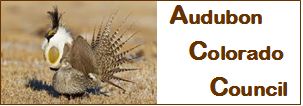September 2022


To find your legislator: Colorado: http://leg.colorado.gov/find-my-legislator
___________________________________________________________________________________
If chapter leaders have questions about resources available to them, they may reach out to Chapter Liaison, Daly Edmunds at 970-416-6931.
______________________________________________________________________________
__________________________________________________________________________________________
Lead Fact Sheet
- Humans face a potential risk of exposure to lead associated with eating wild game killed with lead bullets (CPW “Get the Lead Out”/CDPHE 2008).
- Lead has detrimental effects on the nervous and reproductive systems of mammals and birds.
- Eagles frequently scavenge carcasses of deer, elk and other wildlife that may harbor lead or lead fragments.
- Eagles with lead poisoning may exhibit loss of balance, gasping, tremors and impaired ability to fly.
- Emaciation follows and death can occur within 2 to 3 weeks after lead ingestion.
- Most hunters care about the health of Colorado’s eagles and other wildlife.
- Non-lead bullets are available. Remington, Barnes, Federal, Winchester, Hornady, Nosler all make non-lead ammunition.
- Non-lead bullets are “extremely effective”, “ensure the highest quality meat” and “prevent lethal collateral damage to wildlife”(huntingwithnonlead.org).
_______________________________________________________________________________________
2020 Bob Stocker created an application -https://stockerphotos.com/BirdCodes/ – that allows one to translate bird 4-letter codes, English names, and scientific names into each other. For example, entering “rbnu”, the code gives the result:
IBP 4-letter code English name Scientific name IBP 6-letter code BBL 4-letter code
RBNU Red-breasted Nuthatch Sitta canadensis SITCAN RBNU
__________________________________________________________________________________
Complexities of the Audubon ‘Family’ by Bill Miller, Fort Collins Audubon
At a previous quarterly board meeting of the Audubon Colorado Council I was asked to take a crack at producing something in writing that would help chapters and their members to understand the ”Audubon Family.” The “‘Family” is a complicated collection of one national organization, numerous state and regional offices, affiliated chapters, independent state chapters, local ornithology clubs, wildlife sanctuaries, and even a business that deals primarily with golf courses – all of which use “Audubon” in their organization’s name. It is quite confusing at best.
Late 1800’s – Millions of waterbirds, particularly egrets and other waders with long plume-like feathers were slaughtered for the millinery trade. This practice angered Harriet Hemenway and Mina Hall and led them to establish the Massachusetts Audubon Society in 1896.
By 1898 – Other state-level Audubon Societies had been established in California, Connecticut, Illinois, Indiana, Maine, Minnesota, New Hampshire, New Jersey, New York, Ohio, Pennsylvania, Rhode Island, Tennessee, Texas, Wisconsin, and the District of Columbia.
1900 – Audubon member Frank Chapman started the first Christmas Bird Count as an alternative to the traditional Christmas “Side Hunt,” in which hunters competed to kill as many birds (and mammals) as possible.
1901 – The state-level Audubon groups joined together.
1903 – The state-level Audubon groups helped establish the nation’s first National Wildlife Refuge — Pelican Island in Florida
1905 – A federation of the state-level Audubon groups was established, and called itself the National Association of Audubon Societies for the Protection of Wild Birds and Animals.2
1918 – President Wilson signed the Migratory Bird Treaty Act (MBTA), and shortly thereafter Audubon established its first system of waterbird sanctuaries in seven states along the eastern coast of the U.S., and thus initiated the implementation of large-scale, scientifically-based, bird conservation efforts.”1
1960 – Charles H. Callison, a prominent Washington, DC, conservation lobbyist, came to the National Audubon Society (NAS) as an assistant to its president, Carl W. Buchheister. Callison realized that the key to success in the preservation of wildlife and natural resources was the building of a strong political force and he set out to convert birdwatchers into activists.
1995 to today – Audubon chapters, keyed by passionate and informed members, pressed nationwide for stronger conservation laws and regulations. Beginning in 1995 chapters played an important role in initiating the Important Bird Areas program, applying science-based criteria to identify and protect local habitat for feeding, nesting, and migrating birds.
Currently – Today the “Audubon family” consists of NAS and its state and regional Audubon offices. At the grassroots level are over 500 independent and individual chapters that share common philosophies with NAS. To confuse matters there still remain some of the original independent state-level Audubon chapters. And then there are local organizations that employ the word “Audubon” in their name but are neither an Audubon Chapter nor an affiliate of the NAS. One such organization is Audubon International, legally incorporated as the Audubon Society of New York State but which has no formal affiliation with NAS or the other 500-plus chapters. It provides certification for over 3,000 properties including golf courses, cemeteries, ski areas, housing developments, hotels, and many others.3
The vision of a powerful federation of societies, nurtured by pioneering conservationists more than a century ago, bears fruit today in National Audubon’s network of chapters.
References:
http://www.audubon.org/about/history-audubon-and-waterbird-conservation
https://www.auduboninternational.org/
https://www.learningtogive.org/resources/audubon-society
___________________________________________________________________________________________________________________ RESIST PERSIST
Environmental Organizations:
Center for Biological diversity 520-623-5252; center@biologicaldiversity.org
Rocky Mountain Chapter of the Sierra Club 303-861-8819; rocky.mountain.chapter@sierraclub.org
Wild Earth Guardians 505-988-9126; info@wildearthguardians.org
Union of Concerned Scientists 617-547-5552; ucsusa.org
Great Old Broads for Wilderness 970-385-9577; broads@greatoldbroads.org
American Bird Conservancy 540-253-5780; abcbirds.org
National Audubon Society- Audubon Rockies 970-416-6931; rockies.audubon.org
League of Conservation Voters 202-785-8683; lcv.org
Wild Connections 719-686-5905; wildconnections.org


